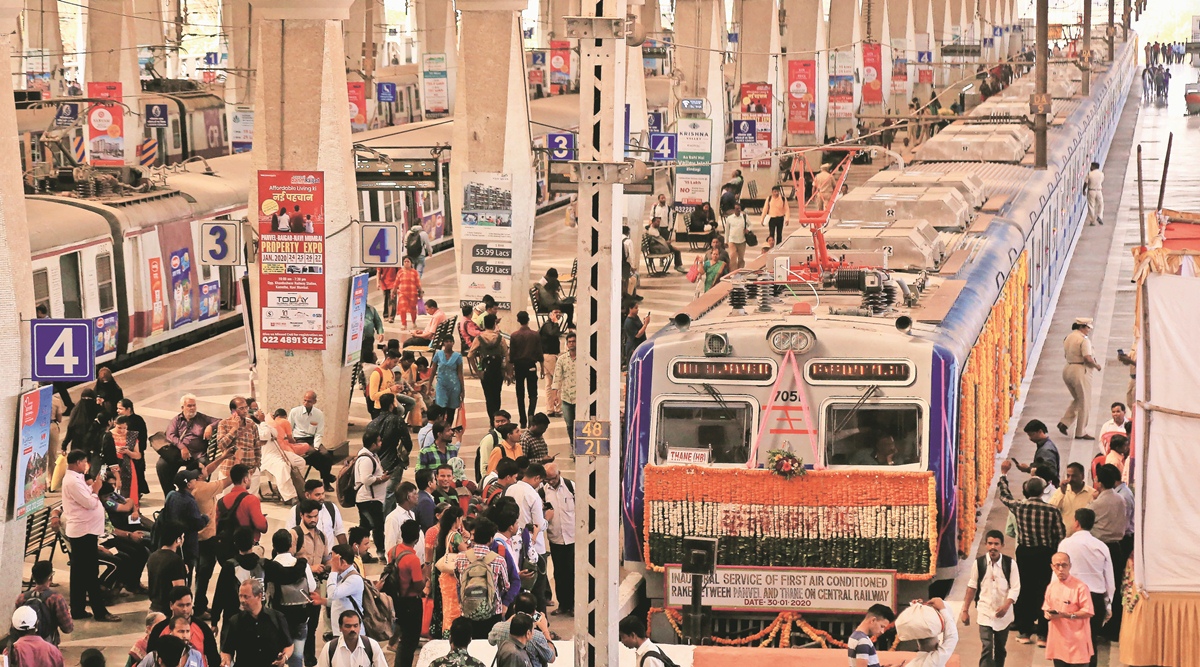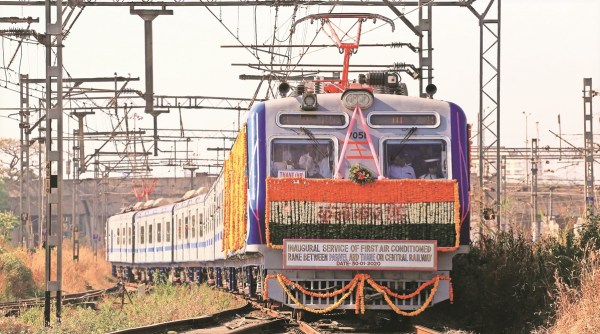 Dia Parwani, Mahesh Deshmukh and Tejaswi Patne. Amit Chakravarty
Dia Parwani, Mahesh Deshmukh and Tejaswi Patne. Amit Chakravarty Written by Sweety Adimulam
It was an initiative that was meant to improve commuting comfort in a city where the suburban rail transit system is jam-packed during rush hour. The inclusion of air-conditioned trains was deemed to be a panacea for the commuting woes of lakhs of commuters who travel long distances in stuffy compartments to reach Mumbai from distant parts of Mumbai Metropolitan Region.
Policy-makers, however, have been perplexed over the protests that have been sparked by the move in parts of Mumbai’s extended suburbs such as Kalwa and Badlapur. The sudden protests and the support extended to the agitators by politicians such as NCP chief Sharad Pawar have brought to the fore the angst of many lower middle class commuters who find these trains unaffordable.
MUMBAI’S SUBURBAN TRAIN SYSTEM
For a linear city like Mumbai, the suburban train services play a vital role in facilitating the north-south movement of the city’s workforce. While the suburban train system is used democratically by every strata of Mumbai’s population, the bulk of its users are the lower middle class and the poor who constitute the majority of the city’s workforce and are forced to travel long distances to come to the commercial business districts in the city.
 An AC local train on its inaugural run from Panvel station on the Central Railway’s harbour line
An AC local train on its inaugural run from Panvel station on the Central Railway’s harbour line The two suburban systems operated by both the Western Railways (WR) and the Central Railways (CR) stretch 319 km. They facilitate inter-district travel in five districts namely Mumbai, Mumbai Suburban, Thane, Palghar, and Raigad. A total of 3,129 services are operated on the Central and Western line in which presently close to 60 lakh commuters travel each day, paying anywhere between Rs 5 and Rs 35 for a one-way ticket and Rs 105 and Rs 500 for a month-long season ticket.
In 2017, the authorities decided to operate air-conditioned trains in the city. As of date, a total of 104 air-conditioned services operate in the city in which around a lakh commuters travel each day paying between Rs 35 and Rs 165 for a one-way commute, and Rs 650 to Rs 3,150 for a month-long season ticket.
WHY THE PROTEST AGAINST AC TRAINS
The general grouse of the protestors is that the fares of these AC trains are too high and have also questioned why the railway authorities are replacing normal train services with AC rakes during rush hour even when the occupancy of the latter is relatively low due to the high cost of travelling.
A daily commuter of CR, Swapnil Gaikwad (33), who lives in Ambernath and works in a private company as a driver at Bandra Kurla Complex (BKC), said that he too wants to travel in comfort and ease but the cost of AC local monthly pass is not affordable. “From Ambernath to Kurla, the cost of a non-AC second class monthly pass is around Rs 315. Whereas the AC local monthly pass for the same distance costs over Rs 2,000.How can one afford such an expensive monthly pass?” he asked.
Another daily commuter of WR, Tejaswi Patne (Kadam), who works in a private bank and travels between Borivali and Lower Parel, suggested that at least first class non-AC ticket-bearers and passholders should be allowed to travel in AC local trains. She too cited the high AC train fares. Patne said that for a non-AC second class monthly pass, she pays Rs 215, whereas the first class pass costs Rs 780 but for the same distance, the AC local monthly pass will cost her over Rs 1,000. She said that the cost of the season pass of non-AC first class is high and the ladies compartment is too small, with fewer seats for passengers.
 Dia Parwani, Mahesh Deshmukh and Tejaswi Patne. Amit Chakravarty
Dia Parwani, Mahesh Deshmukh and Tejaswi Patne. Amit Chakravarty However, other daily service class commuters from Badlapur, Ulhasnagar, who sat in the recent protest against more AC trains that were introduced on CR and later had to be cancelled, cited mismanagement of train timetable and improper planning and study by the railway authorities at large. Commuters Mahesh Deshmukh (34) and Rakesh Nanda (37) both said that non-AC local trains need not replace the AC ones. Here’s why. “On the CR route, there is an evening local going towards Badlapur from CSMT at around 6.10pm which was converted into AC local prior to the protest. But since one local was made AC, the entire crowd shifted to the non-AC local train. This created an outburst. Therefore, to avoid such a situation, Railways should always speak to daily travellers to understand their needs and AC trains should be introduced accordingly, without disturbing the existing non-AC train services timing. Otherwise, the rift will continue.”
Nandkumar Deshmukh, president of Thane Railway Pravasi Sangh, said that the Railways should rationalise this switch to AC local by bringing in a hybrid system where a single rake has the option of both AC and non-AC compartments.
“Railways should run a combination of AC and non-AC compartments in its service. Let commuters decide in which compartment they want to travel. It is good that AC locals have been introduced but the ticket fare is too high for a labourer, or middle class people,” he said.
WHY ARE PROTESTS LIMITED TO CENTRAL LINE
While the passengers of both the Central and Western line are against the new AC trains, the protests have largely been limited to the former. The commuters on the Central line route are completely dependent on railways to reach Mumbai. Travelling daily via roadways using private cab service or by own vehicle is not affordable, given the high fuel prices. The road distance is nearly 39 kilometres just between Badlapur and Thane. Most commuters travel to Navi-Mumbai, South Mumbai, and the Bandra Kurla Complex, where most private offices are located. Whereas, on the Western line route, suburban offices have shifted from South Mumbai to Andheri, Bandra, Goregaon, and Kandivali. A lot of residents staying along these routes can opt for BEST Buses, take auto-taxis, and even the newly launched Metro service 2A and 7 between Dhanukarwadi, and Aarey, and the old Mumbai Metro one that runs between Ghatkopar and Versova. Office-goers and commuters have other affordable public transportation modes, unlike Central Railways.
HAVE AC TRAINS IMPROVED PASSENGER COMFORT?
Close to one lakh people use the 104 AC trains daily in Mumbai. The deployment of these services has definitely improved passenger comfort for commuters such as 39-year-old Sachin Shinde, a frequent AC train commuter from Badlapur to Thane, who works in a multi-national logistics company.
“Badlapur and Thane both have become crowded stations. To board trains from these two platforms has become a Herculean task. Forget getting a seat, getting inside the compartment safely is also a big challenge in non-AC trains nowadays. However, with AC trains, the journey has become smooth. Now, the only demand that I have as a commuter is better frequency of AC trains and a reduction in fares,” Shinde said, adding that he buys single journey tickets from the online mobile application rather than buying a season pass for a whole month due to the poor frequency of AC trains on the Central Line.
Similarly, Harish Marchetty, another daily AC train commuter from Malad to Churchgate, who works in a private firm, said his commute has become stress-free since the AC locals were introduced. Nowadays, even in AC trains, you will see a lot of crowds, he said. In fact, during peak hours, commuters can be seen standing through their trip, which was not the case earlier. “Travelling in AC local trains has just not made my travelling experience ‘cool’ but has given me safety also. It was worrisome to travel on the footboard as non-AC trains are usually jam-packed, with doors open,” Marchetty said.
WHAT ARE THE RAILWAYS’ AC TRAIN PLANS FOR THE FUTURE
The Mumbai Rail Vikas Corporation (MRVC), responsible to carry out development and improvement projects, is expected to procure 238 AC local rakes under the Mumbai Urban Transport Project (MUTP)-3 & 3A – 47 AC rakes under MUTP3 and 191 under MUTP-3A are proposed to be procured by 2024. They will have a life-span of 25 years.
An MRVC official said the Railway Board will decide on the procurement of these rakes before a tender can be floated. The existing AC rakes were procured by Western and Central Railways from Integral Coach Factory (ICF), Chennai.
WHY DID RAILWAYS START AC SERVICES IN MUMBAI
The AC trains were put into service following a Public Interest Litigation by railway safety activist Sameer Zaveri, who lost both his legs in a train accident in 1989. Zaveri’s PIL in 2008 demanded various preventive measures, including closed door local trains to ensure commuter safety.
Subsequently, with the start of air-conditioned Metro lines in the city, the Railway authorities introduced AC local trains in 2017. Zaveri’s PIL was disposed of after the Railway made a submission that it was putting in place measures to improve commuter safety, including starting AC trains.
However, Zaveri feels that while the AC trains are a step in the right direction, the fares need to be rationalised to ensure that all strata of society are able to afford travelling on these services.
“The cost of season tickets should also be reduced like single journey tickets. Otherwise, the purpose of preventing commuters from travelling on the footboard in crowded local trains will be defeated,” Zaveri said.